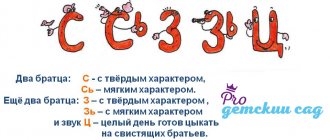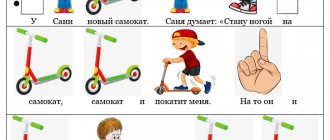June 07, 2022 Article reading time: 7 minutes
12633
When employees fail to cope with their responsibilities, the manager has to delve into all the issues himself or redo the work. As a result, there can be no question of fulfilling the plan, and efficiency and profit are at zero. Don’t rush to fire your team and recruit a new one. It may be worth reconsidering your approach to setting goals.
In the dictionary D.N. Ushakova
STAGE, productions, female. 1. units only Action under Ch. put in 1, 4, 11, 12, 13 and 15 digits. - put. Setting up pillars. Setting up a monument. “The Forest” by Ostrovsky, staged by the Maly Theater. New production of Gogol's The Inspector General. Interesting formulation of the problem. 2. only units. Action under Ch. put in 2 · digits. - put (sports, special). Correct positioning of the horse's hind legs under the body. Voice production. 3. only units. Position, manner of holding some part of the body. Beautiful head position. Correct hand placement when playing the piano. Body positioning when running. 4. Performance, staging (neol.). The best production of the season. Club performances. 5. only units. Organization, device. Good setup. Correct supply arrangement.
What is goal setting and why is it important?
Companies often close in the first year not only because of high competition, but also because of incorrect internal processes. Any work consists of setting goals and objectives. If the goal is the result, then the task is the answer to the question “how to do this?” For example, your goal is to promote your business on social media. Then the tasks, depending on the specifics, are to assemble a team of SMM manager, designer and copywriter, develop and agree on a promotion strategy, calculate the budget and analyze the results. Often tasks are interconnected: the result of one depends on the other.
It is impossible without planning and management: chaotic and uncoordinated actions of employees cause damage to the company. And vice versa - well-organized work in a team contributes to fruitful work.
Thus, the increase in conversion to purchases is associated with the efficiency of employees who receive calls: salespeople, managers and call center operators. If a client waits a long time or cannot get an answer to a question, he will go to competitors. The Workforce Management MANGO OFFICE system solves issues with organizing the work of the first line. The service will help you determine how many employees are needed to complete a task, create an optimal schedule, and analyze the work of employees in real time.
How to set tasks correctly
When setting a task, it is not enough to tell employees about their responsibilities. Everything is important here: wording, details, monitoring the progress of work. Special rules will help simplify communication between a manager and a subordinate.
Distribution of roles
Project work requires a team of different specialists. To do the work efficiently and meet deadlines, each team member must know their duties and responsibilities.
When forming a team, you need to take into account not only hard skills, but also the personal qualities of the employee. This affects efficiency and relationships within the team. Everyone must perform tasks that correspond to their psychotype. It is easier for a disciplined employee, accustomed to control, to carry out routine work, and for a person with creative thinking, it is easier to be creative. Managers need to recognize personality traits and assign tasks to employees with relevant skills and experience.
If all roles are taken into account, then each team member feels comfortable and does what they love, and the number of conflicts is reduced to zero. Efficiency increases, and with it the quality of work and the authority of the company.
Specification of action and result
Vague language is the enemy of efficiency. Often managers assume that employees are familiar with the internal kitchen and do not disclose the details of the task. To avoid misunderstandings, spend more time on clarifications, talk about important and minor points. Then the employee will have a clear idea of what needs to be done and by when.
For example, the wording “attract new customers” is too abstract. It’s better to specify the requirements: “today before 15.00 write and create two posts on Instagram with information about discounts.” Clarifying the details will not take much time, but it will help avoid mistakes.
Appointment of those responsible
Address the task to a specific performer. When a specific person is responsible for the result of the work, the manager understands what stage the project is at, can adjust the process and summarize interim results. This simple action improves the quality of work: employees do not shift responsibilities to each other, but are completely immersed in their work.
Time limit
Set a specific deadline for the task. Not just “the sooner the better”, “in a week” or “in the near future”, but the exact date and time. Employees will do open-ended tasks last. If it is impossible to estimate the operating time, designate control points.
Task tracking
Don’t try to keep all the tasks and deadlines in your head; most likely, you will still get confused. A regular notepad won't solve the problem either. Use convenient programs to set and track tasks:
- for small companies: Google Docs, Trello, Basecamp, Wunderlist, Slack;
- for large projects: JIRA, Redmine, Yandex.Tracker;
- For purposes that go beyond normal planning, CRM systems are used.
Manager's mistakes when setting tasks
To eliminate errors, you need to see them. Let's look at a few basic ones.
Tone of speech
An aggressive tone is only appropriate when discussing matters of life and death. In other cases, communication will be effective if the interlocutors treat each other with respect and are not distracted by personal grievances and emotions. It is important to control intonation and select words - the subordinate’s attitude towards the assigned task depends on this.
Wrong setting of deadlines
For some, “soon” means in two days, and for others, in 30 minutes. You shouldn't hope that everyone has the same ideas about time. Such misunderstandings can affect work. Better set dates for milestones and the final deadline.
Lack of examples
If the employee has not encountered such work before, supplement the instructions with an example. Then he will have an understanding of what result is needed. For example, if you ask an employee to write a commercial proposal for partners, send him examples of competitors’ proposals by email.
To ensure that new employees understand how to speak correctly with a client, they can be trained using prepared templates - special scripts. A well-thought-out conversation script is especially useful where there is no room for error - in cold sales over the phone.
With the MANGO OFFICE Contact Center service, you can create an effective sales script and speed up the training process for new employees. The analytics system will help track the efficiency of operators and improve each stage of work with the client.
Lack of feedback
It happens that an employee does his job poorly even after detailed explanations. Perhaps he did not understand the task and what was expected of him. To eliminate mistakes, seek feedback. Ask exactly how the team will perform the work and if additional information is needed. This seems unnecessary, but it is misunderstanding that becomes a frequent cause of conflicts. Avoid closed questions such as “Do you understand everything?” — they do not motivate dialogue.
Jean-Baptiste Moliere
In France, this playwright is loved with all his heart and in every theater. And there is a reason for it: light style, subtle humor, and ultimately a great mood. Many writers satirized those in power, but Moliere did it with such grace that even today all his caustic phrases are very relevant.
His most popular work was Tartuffe. Almost any theater in the world will definitely stage this play. Everyone wants to see how the cunning servant cleverly tricks the stupid master around his finger.
Tartuffe, Workshop Theater
Automation of the sound "Z"
It is not enough to just pronounce a sound; you need to learn how to use it in your speech. At the next stage after setting, the learned skill is consolidated. First in isolation, then in syllables, words, phrases and sentences.
To automate the sound “Z,” you can practice pronouncing it in poetry, tongue twisters, tongue twisters, riddles, and phraseological units.
For example,
poems with the sound "Z"
pure sayings starting with “Z”
tongue twisters starting with "Z"
And here are some more interesting riddles and phraseological units starting with the letter “Z” at the automation stage.
Puzzles:
Phraseologisms:
hack it on the nose, throw it in hats, it will heal like on a dog, kill the worm.
A speech therapy session on automating problem sounds will be more successful if it is organized in a playful way using color pictures, toys, cubes, lotto and other items.
Here are some ideas for automating “Z”:
- Ask your child to name the colors of the blocks. What color starts with " Z "? That's right, green . Let's add the green cubes separately. What toys contain the letter " Z " in their name? Bunny , bunny , dog Zina . It turns out that a hurricane destroyed their houses, and they decided to build one common house from green cubes. One day, while walking in a green forest, it started to rain. “Where are our zons ?” - the believers shouted . They rushed home, but the evil wolf Zaza was waiting for them . The little girls were not afraid; they invited the wolf to come and wait out the rain over a cup of aromatic tea with strawberry jam.
- Place the colored pictures in a row and let the child choose from them those that depict objects with the letter “Z”.
- You name the word, and the child repeats it in the plural (tooth-teeth, beast-beasts).
Regular practice is an indispensable condition for the development of any skill. Only by being determined to work methodically and with the support of a speech therapist can you help your son or daughter overcome the naughty letter.
Correct articulation of the sound “Z”
The sounds “З”, “Зь”, “С”, “Сь”, “Ц” are classified as whistling sounds as having similar articulation. To learn how to say the letter “Z,” let’s first clarify how the speech apparatus works.
When we pronounce the sound “Z”:
- the lips are slightly stretched, as if smiling;
- the tongue on the sides is pressed against the upper teeth, and at the bottom it rests against the lower incisors;
- a small gap remains between the rows of teeth;
- the soft palate blocks the air stream from exiting through the nose;
- the air passes along the tongue, creating a dull “C”;
- the vocal cords vibrate and “turn on” the voice, without which the sound of “Z” is impossible.
What happens when there is a defect in the reproduction of whistling sounds?
Miguel de Cervantes
The personality of the main character of one of the most popular stories in the world - Don Quixote - can be treated differently. The directors make full use of this adventure, sometimes showing it from diametrically different sides. Which option is more interesting to the viewer is the question, because absolutely all productions are in demand, regardless of whether Don Quixote is a knight in shining armor or a fool who does not notice that he is fighting windmills in vain.
Don Quixote, Mariinsky Theater
Preparatory stage
At the preparatory stage, the correct sound and articulation of the formed “Z” is demonstrated. Articulation and breathing exercises are performed to prepare the child to perform basic positioning exercises.
Types of violations
Violation of the pronunciation of the sounds R and R` is called rhotacism and pararotacism.
There are several options:
- Absence of sound in speech - the child does not use another sound instead (for example, “cow” instead of “cow”).
- Velar - occurs when the back of the back of the tongue rises too much and comes into contact with the soft palate. As a result, a gap is formed and when air passes through it, the walls of the sky create additional noise, which distorts the pronunciation of sound. This disorder is called burr.
- Uvular - only the small tongue vibrates. This type of rotacism is called throat rhotacism.
- Side – the side edge vibrates. When pronounced, the sounds R and L` are combined.
- Bilibial - this type of disorder is rare. The child creates a vibration with his lips and produces a sound similar to “prrr”.
- Labiodental - the sound is produced between the upper lip and lower teeth, and vice versa.
- Single-beat or proto sound - the tip of the tongue makes only one blow on the alveoli, and long vibrations are not obtained. The pronounced sound has a D sound; the child cannot pronounce the long, rolling R.
- Buccal - the air stream passes through the cheek and lateral edges of the tongue, which causes vibration of the cheeks.
- Interdental - the tongue is located between the teeth.
- Laryngeal - the sound P occurs as a result of strong tension of the vocal cords.
Pararotacism is the replacement of one sound with another. The sound R is often replaced with its soft version, or replaced with L, which is simpler in articulation.
This sound is also replaced by the following sounds:
- B - “pavahod” instead of “parachod”;
- D – “duca” instead of “hand”;
- G – “pagavoz” instead of “paravoz”;
- Y – “yiba” instead of “fish”.
Rhotacism may be a reflection of simple dyslalia, when the pronunciation of one sound is impaired. Or is it a variant of complex dyslalia, when the sound pronunciation of several groups of sounds is impaired. Rotacism and pararotacism may indicate more complex speech disorders - dysarthria, alalia, rhinolalia.









